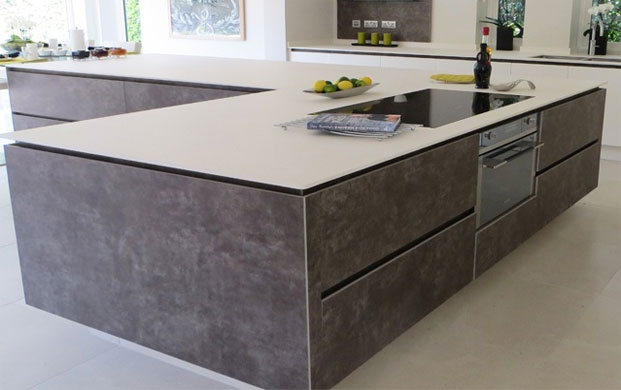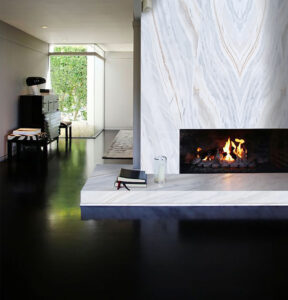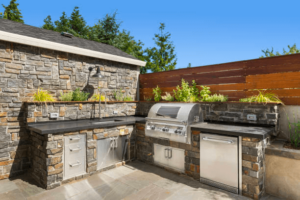Sintered Stone is a popular choice among both designers and homeowners due to the versatility, beauty, practicality and affordability of the product. Brands such as Lapitec manufacture the material that is used for everything from Sintered Stone countertops to pool tiling, but what is Sintered Stone?
How is Sintered Stone Made?
Sintered Stone is manufactured using recent technological advancements which mimic the processes that form natural stones. While natural stones like marble and granite are formed over thousands of years, Lapitec stone slabs take just a few hours.
Minerals and stone particles like the ones found in porcelain or granite are carefully selected for quality, colour and texture. These particles are then subject to extreme heat and pressure – just like they would be deep in the earth’s crust for thousands of years, but achieved much quicker. When the process is finished, the particles are bonded together permanently, without the need for resins or bonding agents, to create Sintered Stone.
What are the Benefits of Sintered Stone?
To the untrained eye, Sintered Stone is almost impossible to distinguish from natural stone – unless it’s been made in some unlikely colour or pattern! Benefits of Sintered Stone include:
- Durable material
- Weatherproof
- Unaffected by heat or cold
- Waterproof
- Stainproof
- Very hard to chip, scratch or damage
- Easy to clean
- Food safe and hygienic
- Non-porous which means the stone doesn’t need sealing
What is Sintered Stone Used For?
Different Sintered Stone brands target their products at different markets, which speaks to the versatility of the stone. It can be used for almost anything natural stone can be. At Surrey Marble & Granite we supply both Dekton and Lapitec collections. Lapitec’s range can be used for the following:
- Kitchen worktops
- Bathroom vanities
- Wall cladding
- Flooring
- Stairs
- Patios and outdoor flooring
- Exterior wall cladding
- Fireplace surrounds
- Swimming pool tiling
- Spas and wet rooms
The main limiting factor is the size of the slabs produced as if you want a particularly huge item, you may need to join multiple slabs together. Fortunately, the consistency between slabs of sintered stone, such as Lapitec, is much higher than between slabs of natural stone so matching is easy. The slabs as manufactured are large enough for very nearly all domestic uses and most commercial uses. As an example, Lapitec slabs are around 3×1.5m (10x5ft), which is the size of a typical single bedroom. Slabs are manufactured in different thicknesses for different uses. No matter which Sintered Stone brand you land on, Surrey Marble & Granite offers many varieties of sintered stone applications to fit your environment.
Sintered Stone vs Quartz
Sintered stone has a better resistance to stains, impacts, heat and chemicals compared with Quartz, heat resistance is a particularly popular characteristic as Quartz can have burn marks or change colour when subjected to heat.
Sintered Stone is an excellent option for outdoor projects as it is weatherproof and waterproof, whereas it is not recommended to use quartz outside.
Both materials are harder than Granite and available in a variety of colours.
To discuss more benefits of Sintered Stone and if it would be the best option for your project, get in touch with an expert at SMG.
Sintered Stone and The Environment
Sintered stone has a relatively positive impact on the environment when compared to some other construction and surfacing materials. Here are some key points highlighting the environmental impact of sintered stone:
Natural Material Composition: Sintered stone is made entirely from natural materials, which means it does not contain synthetic components or harmful chemicals. This natural composition reduces the environmental impact associated with the extraction and processing of raw materials.
Recyclability: Sintered stone is fully recyclable. This means that at the end of its life cycle or if it’s removed during renovations, it can be recycled or repurposed into new products, reducing waste and landfill burden.
Low Resin Content: Unlike some engineered stone materials like quartz, sintered stone does not contain resins. This eliminates concerns related to the environmental impact of resin production and emissions associated with resin-containing products.
Reduced Energy Consumption: The manufacturing process of sintered stone involves sintering, which uses extreme heat and pressure to bond the natural materials together. While this process requires high temperatures, it often results in energy-efficient production because the heat is used to create a strong bond without melting the material.
Use of Recycled Materials: Some manufacturers, like Neolith, incorporate recycled materials into their sintered stone slabs. This practice reduces the demand for new raw materials and minimizes environmental impact.
UV Resistance: Sintered stone’s UV resistance allows it to be used in outdoor applications without degradation, potentially extending the life of the material and reducing the need for replacement.
Longevity: Sintered stone is known for its durability and resistance to wear and tear. Its long lifespan reduces the need for frequent replacements, saving resources and energy in the long run.
Low Maintenance: Sintered stone’s non-porous nature means it doesn’t require sealing or specialised maintenance products, reducing the use of chemicals and water for maintenance.
Overall, sintered stone is considered a more environmentally friendly option compared to some other materials, particularly those that contain high resin content or are not as durable. However, it’s important to consider the specific practices and materials used by different manufacturers, as there may be variations in the environmental impact depending on the source of raw materials and production methods.
Can I install a Sintered Stone Countertop Myself?
It is not recommended that you try to install this product yourself as Sintered Stone needs to be cut precisely using special tools and cannot be adjusted on site (you can’t plane a millimetre or two off if it doesn’t fit). Installation should also be undertaken by professionals as the finished stone pieces are heavy so it’s essential that the stone is properly supported. Any support materials (such as kitchen cabinets) should be checked by experienced stone worktop installers and floors should be professionally levelled to avoid the risk of cracking tiles or slabs when furniture is placed on top.
Sintered Stone Countertop Installation
If you’re looking for expert advice or help installing a Sintered Stone Countertop, our experienced professionals at SMG are on hand to help choose the right options for your project and offer a complete service, from design to installation. Our local experts are available to install your Sintered Stone project to your home or business, speak to our team to find out more.
View our most popular Sintered Stones below.





